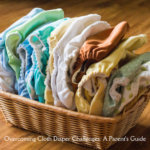Transitioning to cloth diapers can seem daunting for new parents. However, this guide aims to simplify the process, providing you with the knowledge and confidence to choose this eco-friendly and cost-effective diapering option for your child.
Understanding Cloth Diapers
What Are Cloth Diapers?
Cloth diapers are reusable diapers made from natural fibers, man-made materials, or a combination of both. They are an environmentally friendly alternative to disposable diapers, designed to be washed and reused multiple times.
Benefits of Cloth Diapering
- Environmental Impact: Significantly reduces waste compared to disposables.
- Cost Savings: More economical over the long run.
- Health and Comfort: Less chemical exposure for babies, potentially reducing diaper rash occurrences.
FRESH START: THE ESSENTIAL CLOTH DIAPER WASHING GUIDE
Types of Cloth Diapers Explained
Flat and Prefold Diapers
- Description: Flat diapers are simple, single-layer diapers that can be folded in various ways. Prefolds are partially folded flat diapers with multiple layers in the middle.
- Best for: Budget-conscious families, those looking for simplicity.
Fitted, Pocket, and All-in-One Diapers
- Description: Fitted diapers conform to the baby’s shape but require a cover. Pocket diapers have a pocket for absorbent inserts. All-in-Ones include sewn-in absorbents.
- Best for: Parents seeking convenience and ease of use.
Hybrid Diapers
- Description: Combine a reusable outer cover with a disposable insert.
- Best for: Families wanting flexibility during travel or outings.
ECO DIAPERS: SMART CHOICE FOR MODERN PARENTS

Step-by-Step Guide to Using Cloth Diapers
Preparation and Initial Setup
- Washing New Diapers: Pre-wash new cloth diapers to increase absorbency.
- Assembling Necessary Supplies: Diaper covers, liners, wet bags, and a diaper pail.
Folding Techniques
- Basic Folds for Flat Diapers: The pad fold, angel wing fold, and jelly roll fold.
- Securing Diapers: Using diaper pins, snaps, or Velcro.
Changing Routines
- Frequency of Changes: Changing cloth diapers every 2-3 hours or immediately after soiling.
- Dealing with Soiled Diapers: Rinsing off solids, storing in a wet bag or pail until wash day.
ALL-IN-ONE CLOTH DIAPERS: CONVENIENCE MEETS SUSTAINABILITY
Cleaning and Maintenance
Washing Cloth Diapers
- Routine: Develop a regular washing routine—usually every 2-3 days.
- Detergents: Use a cloth diaper-safe detergent to avoid residue and skin irritation.
- Drying: Air dry or tumble dry on low to preserve fabric integrity.
Table: Troubleshooting Common Cloth Diaper Issues
| Issue | Solution |
|---|---|
| Ammonia Smell | Rinse diapers more thoroughly; consider stripping if persistent. |
| Leaks | Check fit; adjust absorbency layers. |
| Diaper Rash | Ensure frequent changes; review detergent and barrier creams. |
HOW TO CHANGE A DIAPER: A GUIDE FOR NEW PARENTS
Personal Insights: A Father’s Perspective
Drawing from my own experience as a father of three, integrating cloth diapers into your routine can seem complex, but with perseverance, it becomes second nature. Here are a few personal tips:
- Stay Organized: Keep your diapering essentials in one convenient location.
- Embrace Community Support: Join online forums and local groups for advice and moral support.
- Be Patient and Flexible: Every child is different, and it may take some experimentation to find the right system.
MAKING THE SWITCH: HOW TO START USING REUSABLE DIAPERS
Conclusion: Making the Switch with Confidence
Cloth diapering is a rewarding choice that benefits your baby, your budget, and the planet. With the right approach and understanding, you can master cloth diapering, making it a fulfilling part of your parenting experience.
This guide provides a comprehensive overview of cloth diapering, from selecting the right type to maintaining your diaper stash, ensuring you are well-equipped to embark on this sustainable parenting journey.







